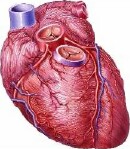
TUESDAY, June 7 (HealthDay News) — Abnormalities identified on the right side of a person’s heart could signal conditions involving both the heart and lungs, according to new research.
In conducting the first large imaging study of the heart’s right ventricle, or lower right chamber, researchers found that the size and pumping ability of the right side of a person’s heart differs, depending on their age, gender and race or ethnicity.
These findings, the study authors concluded, could help doctors recognize changes or irregularities in the size and function of the right ventricle. This, in turn, could enable them to more effectively diagnose problems, particularly cardiopulmonary disease.
“The right ventricle pumps blood to the lungs to pick up oxygen, so all types of lung diseases — chronic obstructive pulmonary disease (COPD), pulmonary fibrosis, pulmonary hypertension, and sleep apnea — can affect the right side of the heart,” study author Dr. Steven Kawut said in an American Heart Association news release. “These results show underlying differences in people without clinical heart disease and could explain the variability of the right ventricular response in people with cardiopulmonary disease.”
Until now, researchers have mainly focused on the left ventricle, the region of the heart affected by high blood pressure and other related conditions. In the new study, Kawut and colleagues examined MRIs from 4,204 men and women, averaging nearly 62 years of age. They found that the right ventricle is smaller but pumps harder in older adults, is larger in men than women, and is smaller in blacks and larger in Hispanics compared with whites.
Based on the study’s norms, the investigators concluded that 7.3 percent of the participants would be considered to have right ventricular hypertrophy (an enlarged heart) and 5.9 percent would have dysfunction of the right ventricle. The study authors noted that these norms could also help doctors identify right ventricle abnormalities in their patients, which should serve as a red flag for possible underlying diseases that involve both the heart and lungs.
The findings may help test the effectiveness of treatments that could be developed for right ventricle dysfunction, the authors noted.
“This study is a first step, but we need to see how the right ventricle changes over five to 10 years in these ‘normal’ people, many of whom have COPD, sleep apnea and other common lung problems,” added Kawut.
More information
The U.S. National Heart, Lung, and Blood Institute has more on lung diseases.

